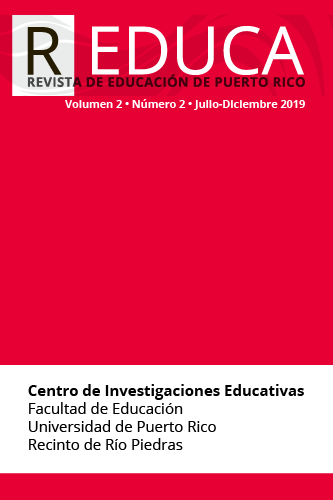Abstract
Case based teaching has shown to improve student perception and comprehension in science courses. However, the existing body of literature lacks direct evidence on its effectiveness in institutions that attends undergraduate Hispanic students. Thus, in an effort to promote the development of analytical skills, we used the "Those Old Kentucky Blues" study and a test to measure students‘ performance and comprehension of Mendelian genetics topic. Student exam scores indicated that when case studies were used, student performance significantly improved in comparison with control groups. Therefore, the incorporation of case study proved to be an effective content delivery method for Hispanic students, improving their perception and performance of the most challenging courses in biology.
References
Abraham, J. K, Perez, K. E & Price, R. M. (2014). The dominant concept inventory: A tool for assessing undergraduate student alternative conceptions about dominance in Mendelian and population genetics. CBE-Life Sciences Education, 13(2), 349-358. doi: https://dx.doi.org/10.1187%2Fcbe.13-08-0160
Browning, M. E. & Lehman, J. D. (1988). Identification of student misconceptions in genetics problem solving via computer program. Journal of Research in Science Teaching, 25(9), 747-761. doi: https://doi.org/10.1002/tea.3660250905
Cendan, J. C., Silver, M. & Ben-David, K. (2011). Changing the student clerkship from traditional lectures to small group case-based sessions benefits the student and faculty. Journal of Surgical Education, 68(2), 117-120. doi: https://doi.org/10.1016/j.jsurg.2010.09.011
DiMatteo, L. A. & Anenson, T. L. (2007). Teaching law and theory through context: Contract clauses in legal studies education. Journal of Legal Studies Education, 24(1), 19-57. doi: https://doi.org/10.1111/j.1744-1722.2007.00033.x
Hilvano, N. T., Mathis, K. M. & Schauer, D. P. (2014). Collaborative learning utilizing case-based problems. Bioscene: Journal of College Biology Teaching, 40(2), 22-30. Disponible en https://eric.ed.gov/?id=EJ1069979
Karagöz, M. & Çakir, M. (2011). Problem solving in Genetics: Conceptual and procedural difficulties. Educational Sciences: Theory & Practices, 11(3), 1668-1674. Recuperado de https://eric.ed.gov/?id=EJ936343
Knight, J. D., Fulop, R. M., Márquez-Magaña, L. & Tanner, K. D. (2008). Investigative cases and student outcomes in an upper-division cell and molecular biology laboratory course at a minority-serving institution. CBE-Life Science Education, 7, 382-393. doi: https://doi.org/10.1187/cbe.08-06-0027
Knipples, M. C. P. J., Waarlo, A. J. & Boersma, K. T. (2005). Design criteria for learning and teaching genetics. Journal of Biological Education, 39(3), 108-112. doi: https://doi.org/10.1080/00219266.2005.9655976
Könings, K. D., Wiers, R. W., van de Wiel, M. W. J. & Schmidt, H. G. (2005). Problem-based learning as a valuable educational method for physically disabled teenagers? The discrepancy between theory and practice. Journal of Developmental and Physical Disabilities, 17(2), 107-117. doi: https://doi.org/10.1007/s10882-005-3683-6
Marra, R., Jonassen, D. H., Palmer, B. & Luft, S. (2014). Why problem-based learning works: theoretical foundations. Journal of Excellence in Collage Teaching, 25(3-4), 221-238. DOI: http://doi.org/10.1007/s10882-005-3683-6
Murray-Nseula, M. (2011). Incorporating case studies into an undergraduate genetics course. Journal of Scholarship of Teaching and Learning, 11(3), 75-85. Recuperado de https://scholarworks.iu.edu/journals/index.php/josotl/article/view/1830
Newman, D. L., Catavero, C. M. & Wright, L. K. (2012). Students fail to transfer knowledge of chromosome structure to topics pertaining to cell division. CBE-Life Sciece Education, 11(4), 425-436. doi: https://doi.org/10.1187/cbe.12-01-0003
Pai, A. (2009). Evolution in action, a case study based advanced biology class at Spelman College. Journal of Effective Teaching, 9(2), 54-68. Recuperado de https://uncw.edu/jet/articles/vol9_2/pai.htm
Pierrakos, O., Zilberberg, A. & Anderson, R. (2010). Understanding undergraduate research experiences through the lens of problem-based learning: Implications of curriculum. Interdisciplinary Journal of Problem-Based Learning, 4(2), 35-62. DOI: https://doi.org/10.7771/1541-5015.1103
Reynolds, J. M. & Hancock, D. R. (2010). Problem-based learning in higher education environmental biotechnology course. Innovations in Education and Teaching International, 47(2), 175-186. DOI: https://doi.org/10.1080/14703291003718919
Rybarczyk, B. J., Baines, A. T., McVey, M., Thompson, J. T. & Wilkins, H. (2007). A case-based approach increases student learning outcomes and comprehension of cellular respiration concepts. Biochemistry and Molecular Biology Education, 35(3), 181-186. doi: https://doi.org/10.1002/bmb.40
Smith, M. K., Wood, W. B. & Knight, J. K. (2008). The genetics concept assessment: a new concept inventory for gauging student understanding of genetics. CBE- Life Sciences Education, 7(4), 422-430. doi: https://doi.org/10.1187/cbe.08-08-0045
Smith, M. U. (1991). Comment on "identification of student misconceptions in genetics problem solving via computer program". Journal of Research in Science Teaching, 28(4), 383-384. DOI: https://doi.org/10.1002/tea.3660280410
Srinivasan, M., Wilkes, M., Stevenson, F., Nguyen, T. & Slavin, S. (2007). Comparing problem-based learning with case-based learning: Effects of a major curricular shift at two institutions. Academic Medicine, 82(1), 74-82. DOI: https://doi.org/10.1097/01.ACM.0000249963.93776.aa
Stewart, J. H. (1982). Difficulties experienced by high school students when learning basic Mendelian genetics. The American Biology Teacher, 44(2), 80-89. DOI: http://doi.org/10.2307/4447413
Walker, J. D., Cotner, S. H., Baepler, P. M. & Decker, M. D. (2008). A delicate balance: integrating active learning into a large lecture course. CBE-Life Science Education, 7(4), 361-367. doi: https://dx.doi.org/10.1187%2Fcbe.08-02-0004
Williams, M., Haydel-Debarger, A. & Montgomery, B. L. (2011). Exploring middle school students‘ conceptions of the relationship between genetic inheritance and cell division. Science Education, 96(1), 78-103. doi: http://dx.doi.org/10.1002/sce.20465
Wolter, B. H. K., Lundeberg, M. A. & Bergland, M. (2013). What makes science relevant?: Student perception of multimedia case learning in ecology and health. Journal of STEM Education: Innovations and Research, 14(1), 26-35. Recuperado de https://www.jstem.org/jstem/index.php/JSTEM/article/download/1659/1507/
The contents published in the Puerto Rico Journal of Education is freely distributed under open access practices, in accordance with the Creative Commons license, Attribution-NonCommercial 4.0 International (CC BY-NC 4.0). Through these principles, the journal and its authors allow readers to access, reproduce and share articles in full text. Users should give credit to authors in a reasonable way without suggesting they have their support. Under no circumstances, readers may make use of the contents for commercial purposes. The authors retain copyright on their works.

